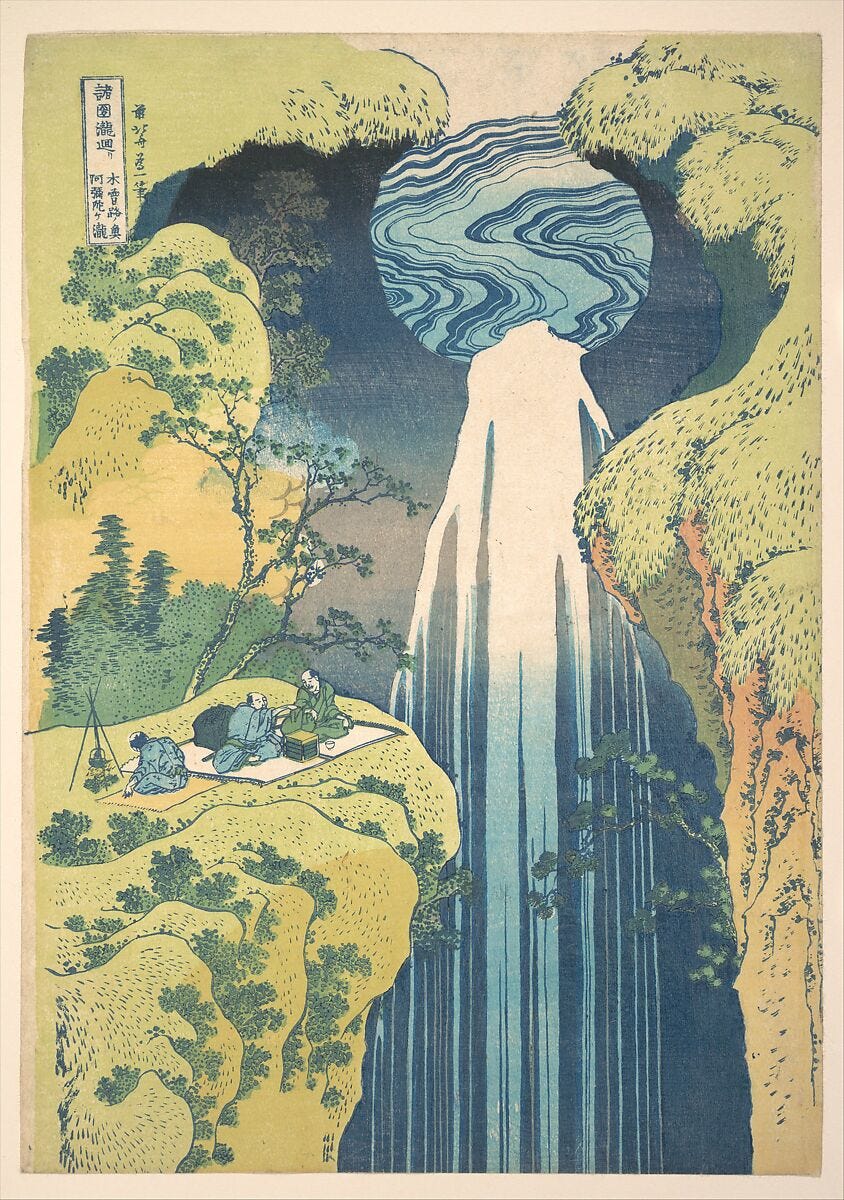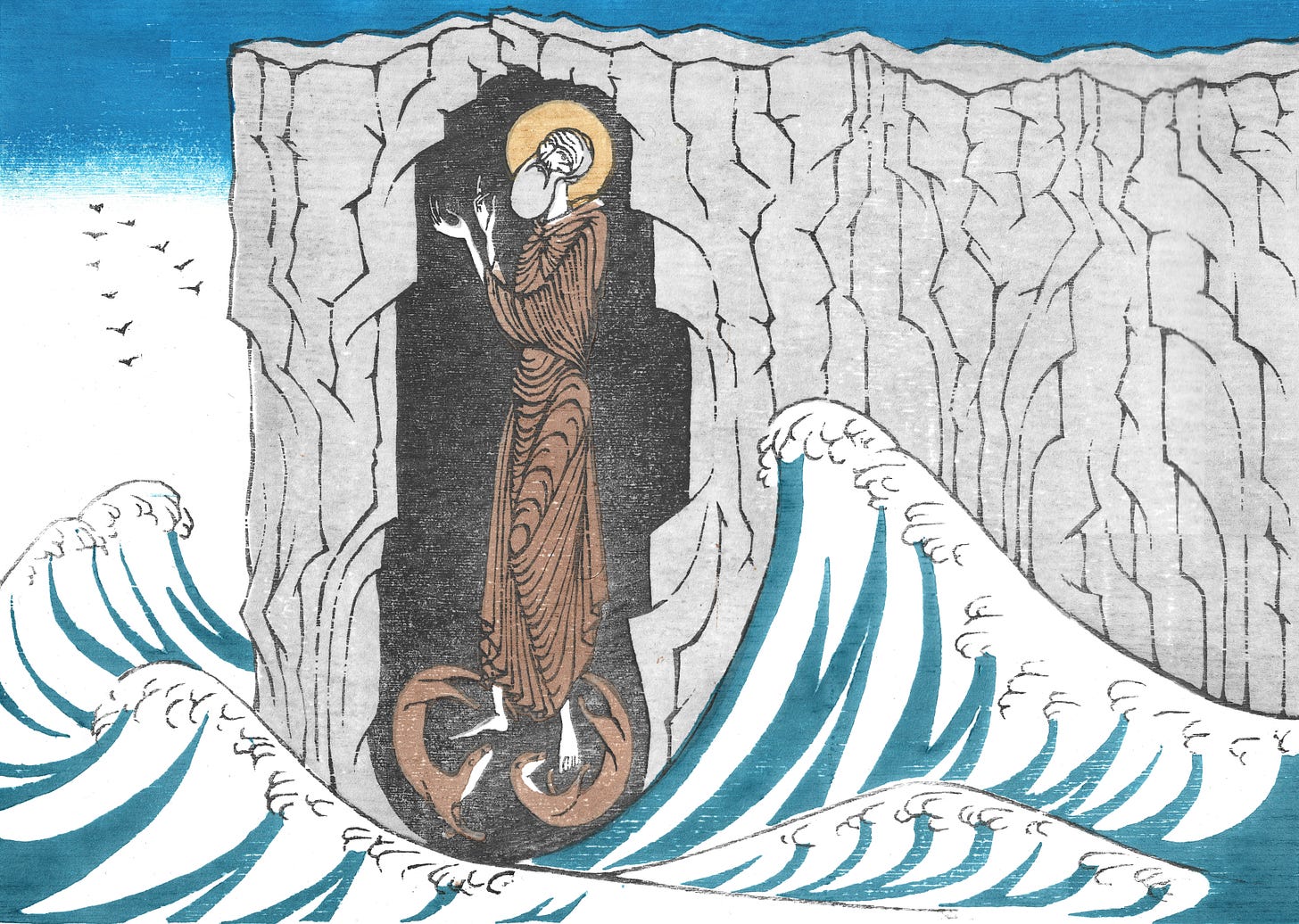St.Cuthbert of Lindisfarne
The creation of the 2nd print to Paul Kingsnorth's Wild Saints series
Two otters warming the feet of St Cuthbert after his vigil in the ocean has always been a very captivating image for myself and many others I’m sure. One take away is that God is watching our feet and where they may tread, and will show up when we pray. I would love to take a pilgrimage up to Durham and see where he rests and visit the lands he once tread. What will be exciting in this series is the variations of landscape, and how they influence the Saints. I think it will be important to reflect the nature of these landscapes in each print. Which is why I am very fond of the Japanese woodcut tradition, particularly Hokusai and Hiroshige. They have found a wonderful way to express the dynamics of nature. The focus wasn’t on perfect reproduction of how they saw things, but an abstracted and lively reproduction of how they saw things. Incorporating the essence of the world in which they viewed. This art one could argue is a lot harder to get right than realistic rendering. If each thing has an essence, a purpose for being, then it is endued with a divine touch, and therefore an infinite quality. The Romanian artist Brancussi expresses this truth far better than I can.
“Reality lies in the essence of things and not their external forms. Hence, it is impossible for anyone to produce anything real by imitating the external form of an object.”

What draws me back to the landscape prints of the Ukiyo-e style is the fine balance of complexity and simplicity, capturing the spirit of the landscape. I think it points to the need to learn and observe the complexity of nature and it’s forms in order to simplify with dignity and not crudeness. Alongside the observation and understanding of nature, tradition is evident, the prints from this time would have been part of a lineage, one that grew out the culture. Skill passed down from master to master. The carving of the blocks is masterfully done, the linework has elegant, delicacy to bring forth the subjects. The placement of the landscapes seem to float in the open space in bold and refined colours. It’s as if they emerge as some memory, the detail isn’t exhausting but just enough to bring to mind the rainfall on a winters evening whilst gazing towards the horizon.

Some of the early western examples of woodcut are quite crude, but still have a charm and aesthetic quality. They are a bit like a frog jumping, it’s not the most graceful or elegant thing you will see, it pings itself off hoping for the best, not controlling it’s movement or weight, with legs flailing in the air, but it will make you smile. The Japanese woodcut is more like a bird taking flight or a deer springing over hedges, there is a delicacy and refinement to these movements, a controlled grace as they move through the air. I hope to capture elements of both.
I think the ability to capture something with simple lines is what strikes me most. Not just in regards to woodcut prints but in other art, I think of Theophan the Greek’s frescoes, they are so unbelievably well executed with simple brush marks, there is such a rich dynamism to these works. It is years of mastery and practice condensed into few brushstrokes. I think it takes a lot of bravery to strip away and only focus on the essentials without getting lost in detail.

I think the landscape of Farne island is a mirror to the faith and endurance of St.Cuthbert. It is a small island up in the Northeast of England, the tide rises and falls, cutting it off from the mainland. These pillars of rock stand firm against the Baltic blasts of the North Sea. I wanted to try capture St.Cuthbert as part of the island, integral to its stability, as if the rock has formed around him. Or some kind of shield wall manifested for protection against the chaos of the sea. I suppose rock, stone and foundations are very much part of the Christian symbolism, it seemed apt to try and create this visually.


There is a clear influence of Hokusai’s waves in this print, the wave is a very powerful symbol, and it’s been captured incredibly by his woodblocks, I hope I channelled this. The drapery is influenced by a mixture of Romanesque carving and manuscript works. I love these works, the drapery seems to be alive and in movement when adorned on a holy person.


I am wanting to keep these prints relatively simple to reflect the theme of asceticism, showing the key elements, with the focus on the Saint, the animals and the landscape. I thought a cold and barren colour palette would work well, I attempted this with a blue, white and grey.
There shall be a recurring theme to keep the hermits in the cave or wherever they may dwell, I do this to try and reflect scripture, 'The light shines in the darkness, and the darkness did not overcome it'. (John 1:15). The cave is a dark, damp and cold place. But the light will always overcome this, such is the strength granted to the hermit Saints.
Here’s to the next Saint! Which I can tease may contain greenery.
If you would like this print, I will be more than happy to make you one:









This artwork is so moving -- truly, an example of beauty as a reenchantment of the world.
Love the concept of beaitiful simplicity which is not easy to achieve. The effort invested is finally rewarded for the artist if no one else.